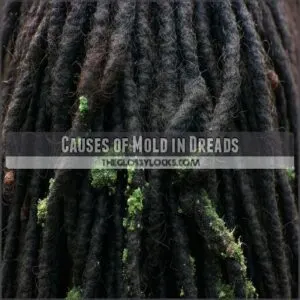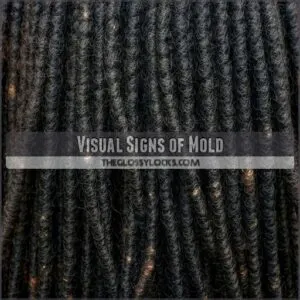This site is supported by our readers. We may earn a commission, at no cost to you, if you purchase through links.

It’s often caused by improper drying after washing, heavy product buildup, or simply living in a humid environment.
Telltale signs include a musty, sour smell, discoloration, or a sticky texture.
Treating it involves deep cleaning with solutions like apple cider vinegar and tea tree oil, followed by thorough drying—think of it as giving your dreads a fresh start.
Prevention is key, though! Wash regularly, dry completely, and avoid heavy, waxy products.
Curious about best practices? There’s more to know!
Table Of Contents
- Key Takeaways
- What is Dread Rot
- Causes of Mold in Dreads
- Identifying Mold in Dreads
- Treating Mold in Dreads
- Preventing Mold in Dreads
- Frequently Asked Questions (FAQs)
- Can you get rid of mold in dreadlocks?
- How do you know if mold is in your locs?
- What is dreadlock rot?
- Can mold spread from dreads to scalp or skin?
- Are gym workouts a risk for mold development?
- What’s the impact of climate on mold growth?
- Can dietary changes affect dreadlock mold prevention?
- Are certain dreadlock styles more mold-prone?
- Conclusion
Key Takeaways
- Dry your dreads completely after washing or swimming because trapped moisture invites mold growth.
- Avoid heavy, waxy products since they lead to residue and slow down drying, which promotes mold growth.
- Watch for signs like a musty smell, discoloration, or sticky textures in your locs to catch mold early.
- Use a vinegar and tea tree oil soak to deep clean your dreads and fight mold effectively.
What is Dread Rot
Dread rot is a type of mold that forms inside dreadlocks when moisture and residue get trapped, creating the perfect environment for growth.
It’s not just an inconvenience—it can lead to unpleasant odors, scalp irritation, and even damage to your locs if left untreated, which makes addressing dread rot crucial for maintaining healthy dreadlocks.
Mold Growth in Dreadlocks
Mold in dreads, or "dread rot," forms when moisture gets trapped inside the dense internal structure of dreadlocks, creating an ideal environment for fungus.
To prevent dreadlock mold:
- Dry dreads completely after washing or swimming.
- Avoid using products that encourage residue.
- Watch for musty smells, a sign of moisture retention.
- Prioritize early detection to prevent severe cases.
Untreated dread rot can lead to follicle decay and odor.
Causes of Dread Rot
When moisture retention mixes with product residue, you’re inviting dreadlock mold. Hair excess dampness from infrequent washing or improper drying leads to moldy dreadlocks.
Add environmental exposure like dust to the equation, and the risk hikes up. Biological factors, such as dandruff or sebum buildup, worsen conditions.
Here’s a quick breakdown:
| Cause | Effect |
|---|---|
| Moisture Retention | Traps dampness inside locs |
| Product Residue | Slows drying, clogs hair |
| Environmental Exposure | Attracts dirt, fosters mold |
The combination of these factors can lead to serious issues, including sebum buildup, which can further exacerbate the problem of dreadlock mold.
Symptoms of Mold in Dreads
A foul odor, like a damp towel left too long, is a key sign of dread rot.
Moldy dreadlocks might also show visual changes, such as whitish or gray spots.
Persistent dampness and texture changes, like excessive moisture retention, are red flags.
Scalp irritation or itching may accompany these hair mold symptoms, making early detection essential.
Causes of Mold in Dreads
Mold in dreads forms when moisture, residue, and dirt get trapped, creating the perfect environment for fungal growth.
Poor drying habits, product buildup, and even environmental factors like dust can all lead to this smelly, frustrating problem.
Improper Drying Techniques
Neglecting proper drying techniques is like leaving a wet sponge in a sealed bag—it invites trouble.
To prevent dread rot and dreadlock fungus, follow these guidelines:
- Use a hairdryer on low heat for appropriate drying time.
- Choose lint-free towels to speed drying.
- Encourage air circulation by separating locs.
- Never sleep with wet dreadlocks.
- Avoid over-tightening sections, which traps moisture, and remember that proper drying is crucial to prevent trouble.
Product Buildup Issues
Using the wrong products can wreak havoc on your locs.
Residue accumulation from heavy creams, wax build-up, or improper shampoo selection traps moisture, promoting dread rot.
Always check product ingredients for non-organic fillers.
Opt for clarifying treatments geared for dreadlock cleaning and maintenance.
Avoid dreadlock fungus by choosing lightweight, residue-free products.
Proper dreadlock maintenance prevents product-related dreadlock problems before they start.
Biological Buildup Risks
Your scalp’s natural balance plays a big part in preventing dreadlock problems.
Sebum overproduction, dandruff concerns, or a bacterial imbalance can create a perfect storm for mildew growth and mold.
These issues worsen with infrequent washing, leading to dread rot.
Regular care and keeping an eye on scalp health can stop hair mold from developing, saving your locs.
Environmental Factors
Environmental factors can sneak up on your locs without notice.
Poor air quality, dust accumulation, or lint buildup (from wool scarves or sweatshirts) traps debris in your dreads.
Seasonal changes, like damp weather, or even your geographic location, can worsen the risk of mold.
Understanding dread rot causes is essential for prevention.
Keeping your hair dry and clean shields against dread rot caused by these unseen culprits.
Identifying Mold in Dreads
You can often spot mold in your dreads by its unmistakable musty smell, like a damp towel left too long.
Watch for whitish discoloration or a damp, sticky feeling that doesn’t go away, even after washing.
The Smell is a Certain Giveaway
If your dreads smell funky, it might be hair mold. That wet-towel scent is a dead giveaway!
Identifying odor isn’t tricky; here’s what to note:
- Smelly dreads persist even after washing.
- Odor location intensifies near the scalp.
- The hair mold smell worsens when wet.
- Foul odor lingers and spreads noticeably.
A loctician can confirm dread rot professionally.
Visual Signs of Mold
Whitish discoloration, spotting patterns, or a fuzz-like appearance on locs can signal dread rot.
Mold thrives in damp environments, causing noticeable texture changes.
Look for visible streaks or patchy growth locations.
While it’s not glamorous, catching hair mold early prevents more damage.
Think of it as your hair whispering, "Hey, take a closer look!"
| Sign | Description | Common Cause |
|---|---|---|
| Whitish Discoloration | Pale or dull streaks along dreads | Moisture trapped inside hair |
| Spotting Patterns | Small spots randomly across dreadlocks | Mold colonies forming |
| Fuzz Appearance | Fluffy or uneven layer on dread surfaces | Residue attracting mold |
| Texture Changes | Stiff, gritty, or slimy texture | Mold growth in hair matrix |
| Growth Location | Patchy areas scattered on dreads | Insufficient drying post-wash |
The signs of dread rot include whitish discoloration, spotting patterns, a fuzz appearance, texture changes, and specific growth locations.
These indicators help in identifying the issue early on, which is crucial for preventing further damage.
Touch and Feel of Infected Dreads
Sometimes, your hands can reveal what your eyes might miss. If your locs feel unusually heavy or faintly gritty inside, it’s a red flag.
Dampness detection is also key—persistent soft spots or sponginess may mean trouble. With dread rot, the texture often changes, feeling uneven or weaker.
Addressing excessive moisture retention is vital to prevent further issues. Catching these abnormalities early can prevent long-term dreadlock damage and hair mold treatment nightmares.
Treating Mold in Dreads
Treating mold in dreads requires a careful approach to remove the fungus while preserving the integrity of your locs.
You’ll need a mix of thorough cleaning, proper drying, and perhaps professional guidance to tackle the issue effectively, ensuring the integrity of your locs is maintained throughout the process.
Washing and Drying Techniques
Think of washing and drying your dreads as a science: balance is key.
Wash once or twice weekly to prevent product residue and mildew in dreads.
Thorough drying is a must—damp locs invite dread rot.
Here’s how:
Consider using a specialized drying tool for faster results.
- Squeeze out excess water.
- Use a hood or handheld dryer on low heat.
- Avoid sleeping with wet dreads to ensure complete drying.
Using Vinegar and Tea Tree Oil
If mildew in dreads has you worried, try a vinegar soak with tea tree oil.
Its antifungal properties fight dread rot effectively. Mix 1 cup apple cider vinegar with 15-20 drops of tea tree oil for an easy dreadlock detox.
Submerge for 10-15 minutes, rinse thoroughly, and towel-dry fully.
Tea tree oil benefits include being therapeutic-grade and effective against dandruff. Repeat weekly for cleaner, fresher locks.
Consulting a Loctician or Dermatologist
When dealing with dread rot, a professional assessment is your best move.
A loctician offers customized dreadlock solutions, from dreadlock detox to structural repairs.
For scalp health and treatment options, a dermatologist is key.
Early detection can save your locs, so don’t wait.
When to consult? If smells linger or you’re unsure, make the call to save your locs with early detection.
Preventing Mold in Dreads
Preventing mold in dreads starts with keeping them clean, dry, and free of buildup.
By following a consistent wash-and-dry routine and avoiding heavy, residue-causing products, you can protect your locs from turning into a moisture trap.
Regular Washing and Drying
Preventing dread rot starts with proper washing frequency and thorough drying methods.
Wash your dreadlocks weekly with a residue-free shampoo, focusing on scalp health.
After washing, wring out excess water and dry completely—air circulation is key.
Using the right product is essential; consider using a shampoo for clean hair.
Use a low-heat hairdryer or sunlight to dry fully, avoiding dampness and ensuring dreadlock hygiene by not skipping this step, which risks trapped moisture harming your dreadlocks.
Avoiding Lint and Environmental Buildup
A simple change in daily habits can help avoid lint and environmental buildup, protecting against dread rot.
- Use a satin scarf or silk pillowcase at night.
- Dry with lint-free towels after washing.
- Limit product application to lightweight, residue-free choices.
- Keep your space dust-free to improve air quality.
- Include routine cleaning to eliminate trapped debris in your dreadlocks.
Maintaining a Consistent Grooming Routine
A strong grooming routine keeps dreadlock health in check.
Wash your hair weekly to avoid buildup and improve scalp health. Use lightweight, natural products for mold prevention.
Invest in satin scarves for night protection and lint control. Remember, dread rot thrives on neglect, so consistency is key.
Consider using specialized products for dreadlock mold prevention. Regular care guarantees healthy, mold-free locks that stay fresh and vibrant.
Frequently Asked Questions (FAQs)
Can you get rid of mold in dreadlocks?
Yes, you can!
Soaking your locs in an apple cider vinegar mix, using antifungal shampoo, and drying them thoroughly works wonders.
If persistent, consult a loctician. Mold’s beatable with patience and the right steps!
How do you know if mold is in your locs?
Where there’s smoke, there’s fire—when you notice a musty smell like damp towels, a whitish tint, or persistent itchiness, it’s likely mold.
Wet dreads feeling sticky or foul odors lingering are clear warning signs.
What is dreadlock rot?
Dreadlock rot happens when trapped moisture and residue within your locs create a breeding ground for mold.
It’s caused by improper drying, product buildup, and neglect, leading to a foul odor and potential scalp issues.
Can mold spread from dreads to scalp or skin?
Think of mold like an uninvited guest—it can spread from your dreads to your scalp or skin, causing irritation, itchiness, or even infections.
Keep your locs clean, dry, and cared for to avoid problems.
Are gym workouts a risk for mold development?
Sweaty gym workouts can increase moisture in your hair, creating a perfect environment for mold if not dried thoroughly.
Use a sweat-wicking headband, wash regularly, and make certain proper drying to stay mold-free.
What’s the impact of climate on mold growth?
Imagine rain-soaked shoes left in a humid closet—mold thrives the same way in wet, warm climates.
High humidity and poor ventilation create a perfect storm for mold, reinforcing the need for dryness and airflow.
Can dietary changes affect dreadlock mold prevention?
What you eat can influence scalp health, which affects dreadlocks.
A balanced diet rich in vitamins and antioxidants, and hydration supports healthy skin, reducing excess oil and buildup that create an inviting habitat for mold growth.
Are certain dreadlock styles more mold-prone?
Ironically, looser, thicker styles—meant to look carefree—trap moisture more, increasing mold risk.
Tighter styles, especially those with poor airflow, also pose a threat.
Proper drying trumps style, ensuring your locks stay healthy and mold-free.
Conclusion
Battling mold in dreads might seem overwhelming, but it’s manageable with the right approach.
Deep cleaning and thorough drying are your best weapons against dread rot, and trust us—your locs will thank you.
Don’t skip regular washing; just remember that moisture is the enemy if left unchecked.
By avoiding heavy products, staying consistent with your grooming routine, and paying attention to your environment, you can keep mold at bay and maintain healthy, fresh-smelling locs.
- https://dreadheadhq.com/pages/how-do-you-get-your-dreadlocks-dry
- https://dreadlockulture.com/do-dreads-smell-bad
- https://drlocs.com/blogs/articles/how-to-determine-if-you-have-mold-in-your-locs?srsltid=AfmBOoqdE0q-4aM6yvEkCRuXtiaFlhkgKXFQ2FxwM4HDKtE33hBco-0R
- https://www.curlcentric.com/are-dreads-dirty/
- https://lovelocsnatural.com/mold-in-dreadlocks-how-to-stop-your-dreads-from-stinking/?srsltid=AfmBOorWDPDROk6cEeFj9Jt5hQtb-Eyzsw-2_VFmD6KpiHqYs_st-np5












